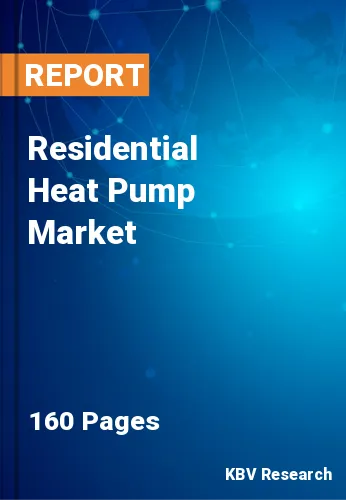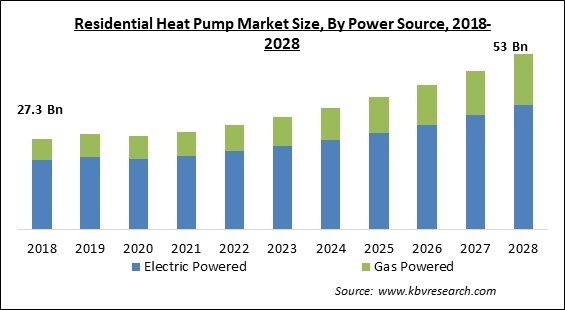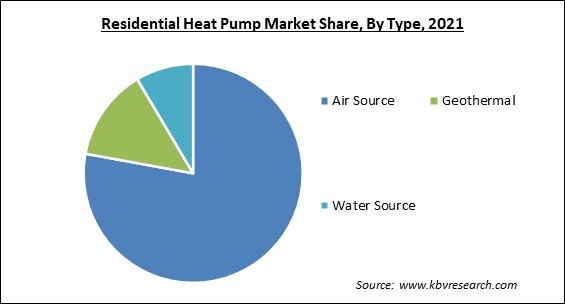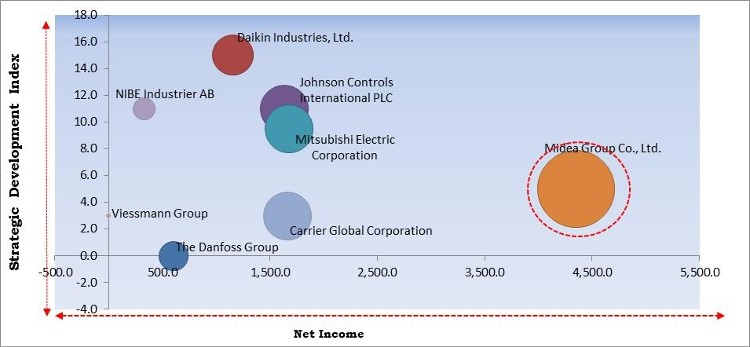
The Global Residential Heat Pump Market size is expected to reach $53 billion by 2028, rising at a market growth of 9.0% CAGR during the forecast period.
Residential heat pumps are external units that are a part of heating and cooling systems. It can cool down home just like an air conditioning unit, but it can also heat it. A residential heat pump absorbs heat from chilly outdoor air and transmits it within the winter, and it removes heat from inside air to cool the home in the summer. They require electricity to run and transfer heat via refrigerant to keep them comfortable all year.

Homeowners may not need to construct separate heating and cooling systems because they can handle both. For improved functionality in colder locations, an electrically heated strip can be attached to the interior fan coil. Residential heat pump, unlike furnaces does not use fossil fuels, giving them more environmentally sustainable.
The reverse cycle chiller (RCC) design, unlike conventional residential heat pump, pumps water instead of air, allowing it to run more efficiently in cold conditions. The residential heat pump in an RCC system is connected to an enclosed water tank, which either heats or cools. The heated or cooled air is then pumped away from the tank and into the ductwork with one or more warming zones through a fan and coil system. An RCC system can also circulate hot water via a radiant floor heating system, so user can thank RCC for keeping bare feet warm on a toasty tile floor this winter.
Heat pumps come in a variety of shapes and sizes, but they all work on the same basic principle, heat transmission. Instead of burning fuel to generate heat, the device transfers heat from one location to another. There's a secret to making it all work. Thermodynamics states that heat typically moves from high-temperature regions to low-temperature regions. A heat pump uses a tiny quantity of electricity to reverse that process, extracting heat from a low-temperature area and pumping it to a higher-temperature location. As a result, heat is transported from a "heat source" such as the ground or air to a "heat sink" such as a home.
Several countries in the world have implemented state-wide lockdowns to stop the virus from spreading further, resulting in a slowdown in the international economy. COVID-19 has adversely affected both the manufacturing and services industries. The pandemic has sparked profound recessions, according to the World Bank, and is projected to have a long-term effect on the international economy due to a drop-in investment and interruptions in international trade and supply chains. The suspension of manufacturing activity and the decline in economic activity for commercial services in 2020 hampered the growth of the residential heat pump industry.
Energy is a vital source of power in many places, including homes, hospitals, and schools. However, its manufacturing and use result in considerable amounts of greenhouse gas emissions. As a result, major economies throughout the world are attempting to minimize their reliance on non-renewable sources of energy and are gradually shifting toward alternative energy sources to reduce greenhouse gas emissions. Residential heat pump technology has the potential to reduce greenhouse gas emissions. Residential heat pump, which use aerothermal and geothermal technology is a cost-effective way to heat a room.
Real-time surveillance, predictive management, and remote diagnostics of components are all possible with Internet of Things (IoT)-based residential heat pump. Smart thermostats in the Internet of Things (IoT)-based residential heat pump help monitor environmental changes and interact with their water heater equipment. Residential heat pump is rapidly being used by end customers from many industries. However, they continue to operate and have the same designs. For ease of operation, automation and distant operations have been primary considerations in the development of next-generation residential heat pump. Residential heat pump now comes with LCD screens and warning lights to make them more user-friendly.

The residential heat pump is a technically challenging piece of equipment. End users in emerging and undeveloped economies have a limited understanding of the fuel efficiency, cost-effectiveness, and environmental benefits connected with residential heat pump, as well as technical know-how. This aspect is likely to limit their penetration in emerging markets. As reported by the United Nations Environment Program, contractors are unaware of ISO regulations for residential heat pump. In order to ensure the safety and quality of our products and services, ISO standards are crucial.
Based on the Power source, the Residential heat pump Market is divided into Electric Powered, and Gas Powered. The electric powered segment procured the largest revenue share in the residential heat pump market in 2021. It is because electric-powered domestic residential heat pump is simple to operate and require electricity to run that has contributed to the growth of this sub-segment. As a result, the possibility of dangerous gas creation is completely minimized during the process. The domestic heat pump is both environmentally benign and cost-effective.
On the basis of Type, the Residential heat pump Market is segmented into Water Source, Geothermal, Air Source. The water source segment witnessed a significant revenue share in the residential heat pump market in 2021. It is Due to its superior operational efficiency when compared to other alternative residential heat pump. A residential heat pump that uses water to capture thermal energy and convert it to heat is known as a water source residential heat pump. The fundamental benefit of a water source residential heat pump is that it may work on the water with a lower temperature than the surrounding air.
| Report Attribute | Details |
|---|---|
| Market size value in 2021 | USD 29.6 Billion |
| Market size forecast in 2028 | USD 53 Billion |
| Base Year | 2021 |
| Historical Period | 2018 to 2020 |
| Forecast Period | 2022 to 2028 |
| Revenue Growth Rate | CAGR of 9% from 2022 to 2028 |
| Number of Pages | 169 |
| Number of Tables | 254 |
| Report coverage | Market Trends, Revenue Estimation and Forecast, Segmentation Analysis, Regional and Country Breakdown, Competitive Landscape, Companies Strategic Developments, Company Profiling |
| Segments covered | Power Source, Type, Region |
| Country scope | US, Canada, Mexico, Germany, UK, France, Russia, Spain, Italy, China, Japan, India, South Korea, Singapore, Malaysia, Brazil, Argentina, UAE, Saudi Arabia, South Africa, Nigeria |
| Growth Drivers |
|
| Restraints |
|
Region wise the Residential heat pump market is analyzed across North America, Europe, Asia pacific, and LAMEA. The Asia Pacific region garnered the highest revenue share in the residential heat pump market in 2021. Due to the colder temperatures in most parts of the region, demand for home residential heat pump has increased, contributing to this increase. Government initiatives are being taken to reduce air pollution caused by traditional energy sources used for heating in households, commercial buildings, and industries.
Free Valuable Insights: Global Residential Heat Pump Market size to reach USD 53 Billion by 2028

The major strategies followed by the market participants are Product Launches. Based on the Analysis presented in the Cardinal matrix; Midea Group Co., Ltd. is the forerunners in the Residential Heat Pump Market. Companies such as Daikin Industries, Ltd., Johnson Controls International PLC,, Mitsubishi Electric Corporation and Carrier Global Corporation are some of the key innovators in Residential Heat Pump Market.
The market research report covers the analysis of key stake holders of the market. Key companies profiled in the report include Johnson Controls International PLC, Mitsubishi Electric Corporation, The Danfoss Group, Daikin Industries, Ltd., Carrier Global Corporation, Midea Group Co., Ltd., NIBE Industrier AB, Viessmann Group, Stiebel Eltron GmbH & Co. KG, The Glen Dimplex Group
By Power Source
By Type
By Geography
The global residential heat pump market size is expected to reach $53 billion by 2028.
Residential Heat Pump Technology’s Contribution to Carbon Reduction are driving the market in coming years, however, In emerging economies, there is a Lack of Understanding of the Benefits of Residential Heat Pump limited the growth of the market.
Johnson Controls International PLC, Mitsubishi Electric Corporation, The Danfoss Group, Daikin Industries, Ltd., Carrier Global Corporation, Midea Group Co., Ltd., NIBE Industrier AB, Viessmann Group, Stiebel Eltron GmbH & Co. KG, The Glen Dimplex Group.
The Air Source market is leading the Global Residential Heat Pump Market by Type in 2021, thereby, achieving a market value of $40.6 billion by 2028.
The Asia Pacific market region shows high growth rate in the Global Residential Heat Pump Market by Region in 2021, and would continue to be a dominant market till 2028; thereby, achieving a market value of $24.1 billion by 2028.
Our team of dedicated experts can provide you with attractive expansion opportunities for your business.
